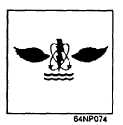| |
AGs observe, collect, record, and analyze
meteorological and oceanographic data. They make
visual and instrument observations of weather and sea
conditions, operate meteorological satellite receivers,
and interpret and apply satellite data. They also
interpret and brief radar imagery and data and interpret
meteorological and oceanographic codes. AGs
additionally prepare warnings of severe or hazardous
weather and sea conditions, forecast meteorological and
oceanographic conditions, and prepare and present
briefings concerning current and predicted
environmental conditions and their effect on operations.
OCCUPATIONAL FIELD 24 (AVIATION
SENSOR OPERATIONS).— This occupational filed
also contains only one rating—Aviation Antisubmarine
Warfare Operator (AW). The insignia for this rating is
a winged symbol of crossed electron orbits pierced
vertically with a lightning bolt heading downward
toward waves.
AWs perform general flightcrew duties. They
operate ASW sensor systems to extract, analyze, and
classify data obtained.
They also perform specified
preflight, inflight, and postflight diagnostic functions
using manual techniques, built-in test equipment
(BITE), and computer routines to effect fault isolation
and optimize system performance. AWs operate tactical
support center systems to analyze and classify ASW
data, assist in aircrew briefing and debriefing, and
provide database information to the tactical commander
for use in prescribing mission objectives and tactics.
You have just read about the Navy’s occupational
fields and the various ratings included in these fields.
Also, do not be confused with the occupational field
numbers.
You probably noticed that we skipped
occupational field number 11. That was necessary
because we no longer have that field. Nevertheless, the
other occupational fields are numbered correctly.
Remember, this information was current at the time this
TRAMAN was being written. For more information
concerning the duties and responsibilities of the
personnel in these Navy ratings and for any additional
information concerning the Navy’s rating structure, we
recommend you refer to the most recent edition of the
Manual of Navy Enlisted Manpower and Personnel
2-26
Classifications and Occupational Standards, Volume I,
part B, NAVPERS 18068, and to appendix F of the
Retention Team Manual, NAVPERS 15878, to find the
current qualifications needed for entry into these ratings
plus additional information on the current duties and
responsibilities of the personnel who are assigned to
serve in these ratings.
SPECIAL QUALIFICATIONS,
INSIGNIA, AND DISTINGUISHING
MARKS
Besides rating badges, naval enlisted personnel
wear other special insignias or designations if they are
qualified to do so. These distinguishing marks are worn
by personnel who have special qualifications in addition
to those required for their ratings.
As a PN, you should be aware of these special
designations.
Some identification badges and breast
insignia worn by eligible enlisted personnel are shown
in figure 2-4. Other badges and breast insignia worn by
officer and enlisted personnel are shown in chapter 10
of the United States Navy Uniform Regulations,
NAVPERS 15665.
In the remaining sections of this chapter, we will
take a brief look at some of these special designations
and their associated titles and qualifications.
MCPON AND FLEET, FORCE, AND
COMMAND MASTER CHIEFS
One of the most prized enlisted marks of
achievement is the insignia for the Master Chief Petty
Officer of the Navy. The MCPON sleeve device as well
as the sleeve devices for fleet, force, and command
master chiefs are shown in figure 2-5. To review the
qualifications and special duties and responsibilities of
the MCPON, refer to the applicable sections presented
earlier in this chapter.
ENLISTED WARFARE SPECIALIST
QUALIFICATIONS
There are three enlisted warfare specialist
qualifications. They are the Enlisted Surface Warfare
Specialist (ESWS), the Enlisted Aviation Warfare
Specialist (EAWS), and the Seabee Combat Warfare
Specialist (SCWS). Attainment of these qualifications
by eligible personnel carries a very special significance,
as explained in the following paragraphs.
|

